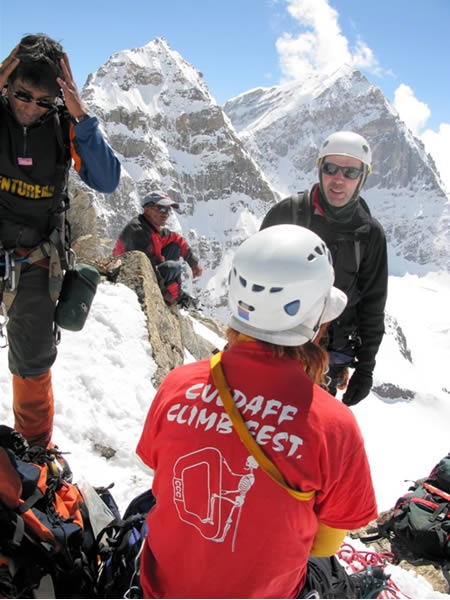Panpatia Expedition, press report. |
| Date: 17th May- 14th June 2008 Submitted by: Alan Tees Irish Panpatia Expedition 2008On Sunday last, a locally organised expedition returned from the Indian Himalayas. Comprising members of Colmcille Climbers and North West Mountaineering Club, the group succeeded in ascending four previously unclimbed peaks, crossing the 4,500m Holdsworth Pass, and reaching the Panpatia ice-cap, where six of them camped for four days at over 5,000m. Three others left the group when base camp was established, and spent ten days trekking to the remote Hem Khund Lake (4,429m) and the Valley of Flowers, above Gangariah , then climbing to the Kaurie Pass (4,229m) to reach Joshimath and meet up with the climbers. The area was first visited by C F Meade in 1912, and then by the famous explorers Shipton and Tilman in 1933, in search of a legendary easy passage through the mountains between the holy temples of Badrinath and Kedernath. The route they found was desperately difficult and they barely survived. Two Indian mountaineers disappeared in 1984 on the same mission, and in 1999, a Himalayan guide, Anindya Muherjee reached the Panpatia ice-cap, a possible link, and wrote about the experience, concluding that a crossing here was possible, but not easy. The following year famous mountaineer Martin Moran’s party first crossed it, and descended to Kedernath. In the last couple of years, a number of parties followed, but none had attempted to climb the virgin peaks that surround the ice cap. Local mountaineer Alan Tees met Anindya in Sikkim in 2006, and plans were hatched to explore, and hopefully climb, from the ice-cap. (In the meantime Anindya visited Ireland to speak at a mountaineering conference at Ballyliffin, Co. Donegal.) In the event, the expedition was not without its setbacks, as early on, on the crossing of Holdsworth Pass, a number of poorly clad porters dumped their loads in the snow, and retreated to Badrinath, resulting in the high-altitude sherpas having to carry heavier loads, and a subsequent delay, in order to hire more porters to carry over essential food and equipment. Due to the immense effort put in by Anindya and his small “Adventuremania” team, lost time was made up, and despite most of the Irish contingent being affected to varying extents by recurring tummy upsets, high camp was established on the 30th May. The next day all six climbers summited on point 5687m, with Anindya and Tindoop Sherpa, and the peak was named Shanti (Peace) Peak. The following day was scheduled for rest and acclimatisation, but five members climbed the spur above the campsite and named it Nasta (Breakfast) Point, 5296m and it proved a superb viewpoint for the entire area. Day three the party had planned to cross the ice-cap to climb an attractive peak on the other side, but that night it failed to freeze, so they spent three hours ploughing through soft snow, before climbing the North summit of what was duly named “Panpatia Ridge”, (and a similar exhausting three hours plodding back). The next morning, only two, plus sherpa and guide, were up for tackling the rock tower (Tindoop Tower) between “Shanti” and the unnamed point 5841m, which proved to be very steep and exposed, but the summit was eventually reached at 9.15 am, and the whole party descended to advanced base camp at 4400m. Three days later, they were back at the roadside. The climbers and trekkers who were on the trip were Dennis Golden (Strabane), George Carlton (Cullybackey), Andrew Tees (Eglinton), Martin Boner (Gweedore), Valli Schaffer (Sligo), Martin Hasson (Feeny), Finbarr Mullin (Dungiven), Margaret and Alan Tees (Culdaff). |
 Summit Shanti. - The peaks behind are 5800 & over 6000m, both unclimbed. |
